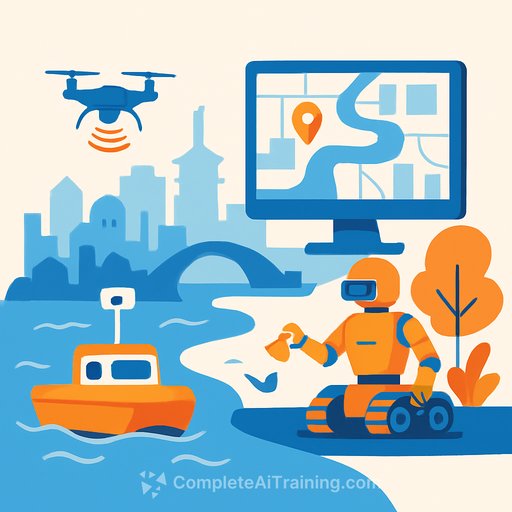AI-Powered Water Management in Beijing: What Managers Need to Know
Beijing isn't a dry city. It's a network of 400+ rivers that support daily life, public health, and urban ecology. With AI-led operations now live on the South Moat and Kunyu River, the city is moving from manual cleanup to intelligent, continuous management.
Here's what changed-and how to apply the same playbook to any city or large facility with complex water assets.
From Manual Work to Intelligent Operations
Two classes of robots anchor the new model: an unmanned vessel for patrol and monitoring, and a multifunctional cleaning robot. As Senior Engineer Zhang Lei explained, these platforms use satellite positioning, programmed waypoints, HD cameras, and more than 20 sensors-including millimeter-wave radar-for full environmental awareness and real-time data streaming. One unit can maintain up to 100 acres per day.
- Autonomous patrols to detect weeds, debris, and incidents
- Real-time situational awareness across air, ground, and water
- Programmed routes plus on-demand dispatch for hot spots
Measured Impact
According to Beijing's Water Environment Management Office, maintenance efficiency has increased by 2-3x versus manual-only workflows. The city plans to operate 28 intelligent robots for daily river and lake upkeep by 2026.
At the city level, integrated waterfront monitoring poles now support rapid response. Brand lead Deng Suli described a coordinated system that deploys aquatic rescue robots, autonomous cleaning units, unmanned vehicles, and drones-shifting from passive response to proactive alerts and smart intervention.
Designing the Operating Model
- Command and control: Central dashboard for routes, incidents, and alerts. Human supervisors approve exceptions, review anomalies, and set priorities.
- Field automation: Unmanned vessels and cleaning robots run daily tasks with autonomous navigation and obstacle avoidance.
- Sensing fabric: Multifunction poles, on-board sensors, and aerial drones feed a unified data layer.
- Digital twin: Start with high-value corridors. As Senior Engineer Lin Chen noted, Wenyu River Park integrates a digital twin and smart monitoring to enable full digital management later.
- Response playbooks: Safety events (falls, spills), environmental thresholds, and equipment faults trigger predefined actions.
KPIs to Track
- Maintenance throughput: acres cleaned per day, route completion rate
- Incident performance: detection-to-dispatch time, rescue response time
- Water quality: turbidity, dissolved oxygen, nutrient levels (aligned with local standards)
- Asset health: robot uptime, mean time between failures, battery cycles
- Cost metrics: cost per kilometer of shoreline, energy use per task
- Safety and compliance: reportable incidents, regulatory thresholds met
Implementation Roadmap (6-12 Months)
- Month 0-1: Map assets and risks (rivers, lakes, hotspots, public areas). Define KPIs and target baselines.
- Month 2-3: Pilot one corridor with 1-2 robots, monitoring poles, and a basic dashboard. Validate routes and incident playbooks.
- Month 4-6: Integrate data streams, automate reports, and train field crews plus dispatch. Add aerial support if needed.
- Month 7-12: Scale to adjacent corridors. Stand up a lightweight digital twin for the most complex zone.
Budget and ROI Levers
- Shift routine cleaning to autonomous routes; redeploy crews to high-skill tasks.
- Cut incident costs with faster detection and coordinated response.
- Extend asset life with predictive maintenance based on sensor data.
- Reduce penalties by keeping water quality within thresholds and improving documentation.
Use the 2-3x productivity gain as an initial planning assumption, then refine with pilot data.
Risk, Governance, and Ethics
- Public safety: Clear fail-safes, manual override, and rescue protocols; signage in public zones.
- Data governance: Video and location data policies; retention limits; access controls.
- Cybersecurity: Secure command links, firmware signing, and network segmentation.
- Environmental safeguards: Noise, wildlife impact, and compliant disposal of collected debris.
- Workforce transition: Upskill operators to robotics supervisors and data technicians.
- Vendor strategy: Open standards where possible to avoid lock-in.
What's Next in Beijing
The city is institutionalizing intelligent maintenance at scale with a planned fleet of 28 robots by 2026. The broader vision connects autonomous cleaning, emergency response, and digital twins into a single management layer-moving from reactive maintenance to continuous, data-led stewardship.
Resources
For Managers Building AI Capability
If you're leading similar initiatives and need structured learning for your team, explore role-based programs at Complete AI Training - Courses by Job.
Your membership also unlocks:






